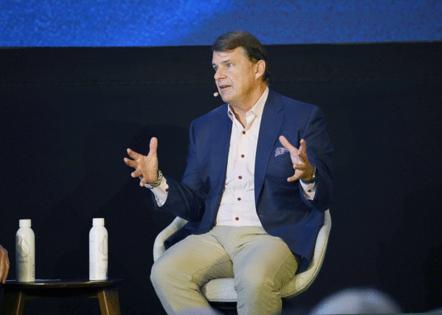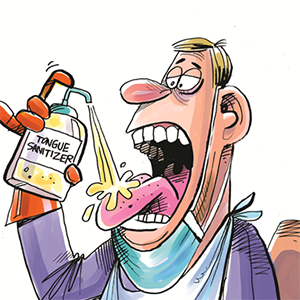How the US auto industry looks at beating the Chinese without becoming them
Published in Automotive News
Detroit’s auto executives say their companies need to beat China’s automakers — but they also can't become them.
China's advancement into the global auto space has accelerated under a political and economic system with major costs: low-cost labor and high rates of automation, mining and refining pollution, a lack of defense of intellectual property rights, limited personal freedoms and privacy rights, and, in some cases, allegations of forced labor.
Yet U.S. automotive executives like Ford Motor Co. CEO Jim Farley recognize China's domestic manufacturers like BYD Co. Ltd. selling less-than-$10,000 EVs are an "existential threat." To combat that is no easy task. But legacy brands, their infrastructure and innovation abilities, policy tools and an experienced and higher-paid workforce may offer U.S. automakers advantages in this race.
"Ford will always advocate for policies by local governments, including ours, to level the playing field," Farley told The Detroit News in an interview. "In the U.S., we're in better shape than we were two years ago, but we are not on par. We don't believe the government's policies yet have equalized the financial subsidies that are exported."
He said he's optimistic, though, because even compared to a year ago, it seems there is bipartisan intent to ensure the U.S. industry can compete.
Tensions between the United States and Communist Party-controlled China have been ongoing for decades. Chinese President Xi Jinping has said the countries can only choose to be partners or adversaries. U.S. President Donald Trump has used similar language to describe China, as well, and instituted high tariffs on the country. China has retaliated with its own tariffs and export restrictions.
China's advancement in the auto industry has been decades in the making. After former President and CCP Chairman Mao Zedong's death, foreign automakers in the 1980s could begin to enter China by manufacturing through joint ventures with domestic, usually state-controlled manufacturers. Still, sales volumes only passed 2 million in 2001 when China entered the World Trade Organization.
That opened the floodgates for investment, said Bill Russo, CEO of consulting and investment platform Automobility Ltd. in Shanghai. Supply chains were built in earnest. By 2009, almost 14 million vehicles were being sold in China. That growth has slowed. In 2017, it reached almost 29 million, and last year, there were more than 31 million vehicles sold in the country. But electric and plug-in hybrid vehicles now represent a majority of sales, and Chinese brands outsell foreign rivals.
Made in China 2025, a national industrial policy launched in 2015 to advance China's manufacturing sector, and support for "new energy vehicles" created a consistent, long-term direction that the rest of the world doesn't have, Russo said.
"That consistency contrasts very sharply with the U.S. policy that swings and operates within a politically polarized environment," he added. "That's China's huge advantage over the United States."
Trump has repealed portions of the Inflation Reduction Act that his predecessor, Joe Biden, signed in 2022, including a consumer EV tax credit. He's also proposed rolling back tailpipe emissions regulations instituted under Biden.
Between 2009 and 2023, China poured at least $230 billion of subsidies into its domestic EV sector, according to the Center for Strategic and International Studies. And that's a conservative estimate — excluding local and provincial support, funding for the supply chain like EV battery makers and assistance in the form of low-cost land, electricity and credit.
"We think of China not so much as hyper-efficient as hyper-effective," said Michael Dunne, a former General Motors Co. executive-turned-CEO at consultancy Dunne Insights LLC. "They're not that efficient. They throw around a lot of resources. They ask people to work like crazy. They mess up their environment, but net, they're winning in industry. So, there's a trade-off. The leadership there is willing to make that trade-off. We're not. That's a big dilemma.
"So, what do we do here? I think back to post-Pearl Harbor. The U.S. probably put in motion a lot of activities and just said there's trade-offs, but in a sense, we're at war. What are we willing to give up to maintain our independence?"
Involution
State-owned enterprises, higher consumption taxes, land sales and below-market financing through state-owned banks and regulations contribute to China's ability to support subsidies. Its population is also four times larger, providing a larger tax base, an alluring market for business and a robust labor pool.
The support has created a proliferation of EV businesses with the capacity to assemble half the world's annual production of vehicles and intense competition. The result has been a downward price spiral, creating concerns among authorities in what's been dubbed "involution" — a term initially used to describe hyper-competitive academic and professional lives among young people. BYD's third-quarter net income, for example, was down 33% year-over-year to $1.1 billion (CNY 7.8 billion).
The government has reduced subsidies and is evaluating tools to address the price war. There has also been consolidation in the industry, with the top 10 EV makers accounting for a larger share of the market than three years ago, said Xiao Feng, co-head of China industrial research at capital markets group CLSA Ltd. in Hong Kong.
"We're seeing a signal of stabilizing price cuts, especially after the government stepped in, something they call the anti-involution campaign," he said. "The base case scenario is for 2026; there will be easing price cuts in the industry trying to switch from a price war to a value or feature war going forward."
He anticipates this will include intelligence driving features like automated parking becoming standard, as well as longer-range and faster-charging vehicles.
Chinese automakers have also increasingly looked to overseas markets to sell. Tariffs and other regulations imposed by Europe and the United States, however, have challenged expansion. Still, Chinese brands' sales in Europe are growing faster than those of Audi or Renault. In places with fewer obstacles, such as Australia, Chile and Peru, they represent 20% of sales or more.
"Eventually, you'll run out of other people's money, but they're buying time and market share," said Terry Woychowski, president of automotive at Caresoft Global Technologies Inc., a benchmarking consulting firm, and a former GM executive. "They compete to take food off your table and put it on theirs. Work-life balance? There is no work-life balance. Your family can enjoy the benefits of that if you're providing. The toll of that is heavy."
A frequent anecdote Woychowski mentions is a scene from when he visited China. He walked around ShanghaiTech University's campus, an interest since Woychowski is a board member for Michigan Technological University.
"I walked through the library — Sunday morning — jammed. Every table, every seat taken, heads down," he said. "Then I think back to what's going on this Sunday morning at my beloved Michigan Tech. I guarantee you this: The library is not full."
Advantages and weaknesses
There is plenty the U.S. industry can learn from China, Woychowski regularly repeats at public appearances. He's emphasized economies of scale the Chinese achieve through components sharing, focusing on consumer value and creating a small team to break rules and introduce product that can compete with the production costs and vehicle-development speed of Chinese companies.
Ford created its own skunkworks team, which started in California, for that purpose. The first EV — a midsize truck starting at $30,000 — from that group will launch in 2027 at Louisville Assembly Plant in Kentucky with a reimagined manufacturing system that breaks from the traditional moving assembly line Ford pioneered more than a century ago.
"We have to get close on cost, if not equal to cost, and we think we're there in the case of an electric vehicle here in the U.S. versus an import of Mexico product," Farley said about the Universal Electric Vehicle platform and production system. "Every day goes by, it's just clear what a good decision that was. We have a lot of work to land the plane on the UEV in Louisville, but thank goodness we did that."
GM referred comment on the costs of China's advancement in EVs and domestic competitive advantages to the Alliance for Automotive Innovation, which directed The News to Dunne and Stephen Ezell, vice president of global innovation policy at the Information Technology and Innovation Foundation. Stellantis NV declined an interview request.
RJ Scaringe, CEO of EV startup Rivian Automotive Inc., said Chinese automakers don't utilize anything on the manufacturing side that's particularly unique compared to his company or Tesla Inc. Its cost advantages, he said, lie in generous subsidies as well as cheaper labor costs. The "9-9-6" culture refers to a common work schedule of 9 a.m. to 9 p.m. six days a week.
"The idea that you live at the plant, you work six days a week, you work 10 hours a day and you make five bucks an hour — it's not something that you want to have," Scaringe recently said before the Automotive Press Association. "There's not a line of people in the United States saying, 'I want that kind of job.'"
He said he doesn't see a U.S. policy that would allow Chinese products without tariffs. Otherwise, it would have to allow Western manufacturers to import to benefit from those same advantages to compete. Meanwhile, if these Chinese automakers were to manufacture in the United States, their cost advantage would disappear.
"I think in most cases, the cost structures will be brought to equilibrium, where those structural gains differences are balanced," Scaringe said about Rivian compared to Chinese companies.
Rivan doesn't sell in China. But, Feng said, the success of Chinese automakers over foreign rivals shows they aren't just relying on cheaper labor: "Chinese automakers are still taking market share from Volkswagen, Toyota, Tesla, for years, even though they are paying the same level of salaries in China."
Some experts have suggested that U.S. companies borrow China's playbook. They could tie up with Chinese automakers looking to manufacture in North America, arguing it's inevitable their products will end up here, and they can learn from them.
Stellantis has a joint venture with Zhejiang Leapmotor Technology Co. Ltd. to manufacture and sell its EVs outside China. Ford doesn't have a joint venture with Chinese battery giant Contemporary Amperex Technology Co. Ltd., but it's licensing its technology to manufacture a cheaper, more fire-safe battery in Michigan.
Access to intellectual property is a key need to ensure a level playing field with China, Farley said. Industrial independence, he said, entails: U.S. tariffs that have headed in the right direction, similar internet-connected software vehicle regulations to what China has that the United States adopted earlier this year, protections from currency advantages and a robust supply chain for rare earths, whose refining China dominates, semiconductors and other raw materials.
But as far as tying up, Ford feels its UEV system is the "right model for this inning of our competition," Farley said. Globally, he said the company is open to all partnerships that allow it to compete successfully.
For Rivian's part, Scaringe says he doesn't see an advantage to tying up with Chinese automakers. Their technology advantages stem from a zonal electrical architecture that reduces the number of computers — known as electric control units — in a vehicle, saving on costs and making it easier to update over-the-air. Rivian already has that, he said.
China also has taken efforts to protect its lead, contributing to expectations by Chris Liu, senior automotive analyst in Shanghai at technology research group Omdia, that Chinese automakers won't increasingly enter the U.S. market for at least five years. CATL's challenge in completing a joint venture in the United States is a sign of this, he said. Additionally, new controls limit exports for highly energy-dense batteries and equipment for their manufacturing.
Additionally, former FBI Director Christopher Wray has warned about efforts by Chinese companies to steal EV intellectual property. Relying on onshoring and supply chains of allies is a means of protection, Ezell said: "It's going to be the strength of our domestic ecosystem that is going to sustain us or not."
Last year, U.S. Rep. John Moolenaar, a Michigan Republican from Caledonia, chairman of the Select Committee on the CCP, in letters to the Homeland Security Department, also accused Chinese battery manufacturers CATL and Gotion of supplying materials from companies associated with state-sponsored forced labor programs and the Uyghur genocide. Moolenaar has been outspoken against Ford's CATL licensing agreement and Gotion's plans for a plant outside Big Rapids, which appears at least delayed.
"Many companies have benefited from these unfair practices," Ezell said. "Our companies simply shouldn't be engaging with those that have come to their position through untoward means."
Although increasing EVs in China has reduced tailpipe emissions and problems with smog, environmental groups have also raised concerns about the sector's supply chains. Lead the Charge's 2025 scorecard, an assessment put together by advocacy groups like the Sierra Club and Climate Rights International, ranks Chinese companies GAC, SAIC and BYD at the bottom of the list, featuring 18 major automakers looking at their supply chains' impacts on the environment and human rights. Geely was No. 11, and sibling Volvo was No. 4.
Low rankings, however, were influenced by a lack of transparency on some criteria. Climate group T&E also has found that carbon emissions of EV batteries produced in Europe are 37% lower than those produced in China.
"We can't move from one extractive industry where we were drilling for oil, and that's how we fuel our vehicles, and then moving it to another very extractive industry, which includes mining for critical minerals for electric vehicles," said Katherine Garcia, director of the Sierra Club's Clean Transportation for All campaign.
Despite China's advantages, there are strengths for its competitors. Legacy brands have consumer loyalty, familiarity with customers that can spur innovative ideas, history with competition and built-out dealer networks.
The United States also has some of the best universities in the world, though the Trump administration's grant funding cuts could affect research and innovation. Many U.S. autoworkers are experienced and have protections around collective bargaining. There are no independent labor unions in China.
"The U.S. automakers here have a history and skillset and linkages to universities as well as a highly motivated workforce," said Harley Shaiken, a professor at the University of California, Berkeley. "Are workers more expensive? That translates into higher productivity and better quality."
As Chinese automakers expand and operate outside of China, there can be some cultural clash, Liu said: "A lot of these folks do not see their paychecks increase as much as they used to, and it has been influenced badly by Chinese manufacturers, because they've been cutting their costs, cutting their prices, so nobody has seen their paychecks grow, and that has been creating the sentiments against Chinese manufacturers, against China, and that's being a huge issue for China trying to export overseas."
In China itself, though, the situation appears comfortable for now, he said. But under current circumstances, it's unclear how long that could last, Russo said.
"We need to reimagine America as the sustainable, ethical and people-centric mobility problem solver, which contrasts with China's approach, which is intense, hyper competition and race to dominance," he said. "There's a risk that that can burn out."
©2025 www.detroitnews.com. Visit at detroitnews.com. Distributed by Tribune Content Agency, LLC.








Comments